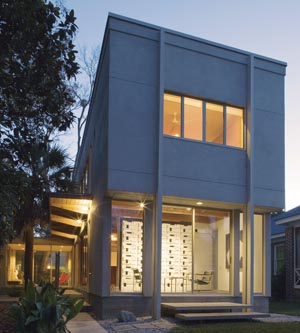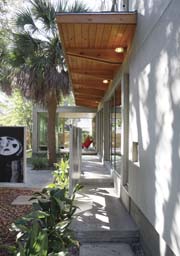An Affordable Sustainable Home
by Rolf Priesnitz
photography by Richard Leo Johnson
Beauty and economy combine with sustainability in this passive solar home that is designed to fit gracefully into an existing urban neighborhood.
 Architecture professor Tim Woods calls his home and fine art studio/gallery in historic Savannah, Georgia a “living machine.” Woods’ design challenges the idea of “human versus nature” and is instead a partnership between Nature and architecture, adapting to its environment, changing with the seasons and promoting sustainable living. Architecture professor Tim Woods calls his home and fine art studio/gallery in historic Savannah, Georgia a “living machine.” Woods’ design challenges the idea of “human versus nature” and is instead a partnership between Nature and architecture, adapting to its environment, changing with the seasons and promoting sustainable living.
Using a raised concrete slab, steel columns and wood frame/ stucco construction, the 16-foot- wide, two-story home has a flat roof and an expanse of glass oriented toward the sun and overlooking a water-efficient garden. That connection with the outdoors and the easily reconfigured open-plan interior layout allow a relatively small space to seem larger and provide a connection between the natural and built environments. They also create the opportunity for plenty of cool, natural reflected light, as well as cross-ventilation.
The concrete slab on which the house is constructed has been polished but otherwise left uncovered. That allows it to absorb and store the sun’s energy by day, to be used as radiant heat in the evening. Overhangs prevent overheating during the summer. The flat roof supports hydroponic gardens using mound crops such as squash and cucumbers and a solar hot water system and could also easily accommodate photovoltaic panels.
Woods’ goal was to build an energy-efficient, modern building that would help dispel the myths that a green home is prohibitively expensive and inaccessible to most people. And it appears that he succeeded. The “Living Machine” was completed in 2006 for $80 a square foot, which is much less than the local average of $120. His average energy bill is $100 per month, compared to $215 for a house of the same size in Savannah.
Woods believes in prefabrication as a way to keep construction costs low and structures environmentally-friendly. The Living Machine is an experimental prototype for affordable, prefabricated modular homes, designed to be built using local materials in local factories. These local materials contain little embodied energy and the modular sections can be easily constructed by local labor. Woods also notes that a house that is built to last breaks the cycle of waste.
The prefabricated versions that he has dubbed “LOCI MODulars” have flexible floor plans from 1,000 square feet to 3,500 square feet. They are able to adapt to all climates and any site with flexible window placement that responds to solar orientation, vegetation and cross ventilation to create a passive solar dwelling, just like his prototype home and studio.
Read more in this PDF file of the article, along with additional photos.
|

